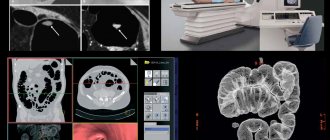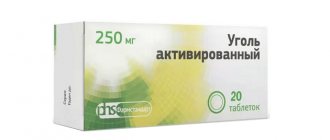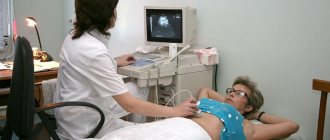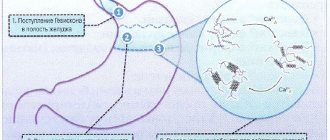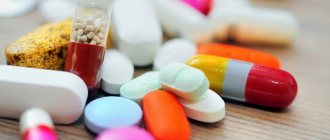Enteropathogenic Escherichia coli
This class of E. coli causes various intestinal infections. These E. coli bacteria cause severe diarrhea with watery stools, severe abdominal pain and vomiting. This type of intestinal infection (caused by enteropathogenic E. coli) is also called “travelers' diarrhea.” Infection with enteropathogenic E. coli does not require treatment.
Enterotoxigenic Escherichia coli
This species is distinguished by the fact that E. coli attach to the epithelium of the small intestinal mucosa and produce toxins. Enterotoxigenic Escherichia coli is one of the causes of acute diarrhea in children.
Enterohemorrhagic Escherichia coli
These E. coli cause hemorrhagic colitis. They are very dangerous, since in most cases they cause microangiopathic hemolytic anemia, combined with renal failure.
Symptoms of this disease, caused by enterohemorrhagic Escherichia coli, include severe abdominal pain and watery diarrhea (which then becomes bloody). There is no fever, but the temperature can reach 39 °C.
Enterohemorrhagic E. coli can be contracted through contaminated food and water, as well as from sick people or animals. The incubation period lasts from 2 to 3 days. Symptoms of enterohemorrhagic E. coli are cramping abdominal pain, bloody diarrhea. Fever and vomiting may also be present. Typically, an infectious disease caused by enterohemorrhagic E. coli goes away within 10 days. However, you should seek help from a doctor, as enterohemorrhagic E. coli can lead to serious illness.
Enteroinvasive Escherichia coli
Diseases caused by enteroinvasive E. coli are very similar to bacillary dysentery. Symptoms: abdominal pain, watery diarrhea mixed with blood. Treatment of diseases caused by such E. coli is prescribed by a doctor.
Hemolyzing Escherichia coli
Such E. coli may be present in the body and not manifest itself. As soon as the conditions for its development are favorable (illness, weakened immunity), hemolyzing E. coli will manifest itself.
Children suffering from large amounts of hemolyzing E. coli are prone to diathesis . Symptoms include bloating, diarrhea, constipation, mucus or green matter in the stool. It should also be noted that with hemolyzing E. coli, the patient’s temperature does not increase.
The effect of hemolyzing Escherichia coli on the body is reminiscent of Staphylococcus aureus . Hemolyzing E. coli is especially dangerous for newborns. Since even a small amount of it can disrupt normal digestion in a child.
Symptoms and signs of infection
Depending on the type of bacterium that led to the development of escherichiosis, infection can be recognized by the following characteristic signs:
- Enteroinvasive rod. This pathogen can cause acute intoxication in both adults and children. Clinical symptoms of infection with enteroinvasive bacillus are similar to those of dysentery. Infection is indicated by frequent urges to have bowel movements (up to 25 times a day), general weakness, nausea, and stools acquire a watery consistency and may contain mucus impurities.
- Hemolytic (enterohemorrhagic, hemolyzing) bacillus. This pathogenic microorganism causes hemolytic-uremic syndrome in adults, and in children it provokes hemorrhagic colitis. Both diseases require timely treatment.
- Enterotoxigenic. Symptoms of infection with this microorganism include nausea and frequent episodes of vomiting, severe diarrhea, and cramping pain in the umbilical region. This type of intestinal infection is equally common among adults and children.
- Enteropathogenic escherichiosis. If E. coli is detected in an infant, then in 80% of cases we are talking about enteropathogenic escherichiosis. Infection can be recognized by symptoms such as diarrhea and vomiting. A newborn baby refuses to eat, there is frequent regurgitation, restlessness, continuous crying and insomnia.
Standard treatment for E. coli includes taking medications that have a detrimental effect on the microorganism, as well as drugs to eliminate the symptoms of intoxication.
Treatment
To treat symptoms of E. coli in adults and children, the following groups of drugs are used:
- Antibacterial agents. Traditional treatment of E. coli in the urine, in the vagina in women and in the lumen of the large intestine includes taking antibiotics from the group of cephalosporins. The course of treatment is from 5 to 10 days.
- Antispasmodics and painkillers. Painkillers for the treatment of E. coli symptoms in adults and children are prescribed for severe pain. For therapeutic purposes, drugs such as Nurofen, Spasmalin, No-shpa are prescribed.
- Probiotics. This group of drugs helps restore the balance of normal microflora in the lumen of the large intestine and vagina in women.
In order for probiotics containing bifidum and lactobacilli to effectively restore microflora, their intake must be combined with prebiotics, which create a favorable environment for the proliferation of beneficial bacteria. The combination drug Stimbifide Plus, which is a metaprebiotic and contains a unique combination of fructopolysaccharides and fructooligosaccharides, has proven its high effectiveness against escherichiosis.
Metaprebiotic Stimbifid Plus provides the microflora of the large intestine and vagina with unique nutrition, thereby stimulating its reproduction. Based on the results of clinical studies, a comparative characteristic of the effectiveness of Stimbifid Plus and other drugs that affect the composition of the intestinal microflora was compiled. Metaprebiotic has proven its absolute leadership. The dietary supplement Stimbifid Plus is equally effective for the prevention of both escherichiosis and other diseases.
How does infection occur and the effect of the microbe on the body?
Infection can occur through nutritional routes. The bacteria enters the mouth, then further into the stomach and intestines. Colonizes in the small and large intestine. Can cause microcirculation and blood coagulation disorders. Leads to disruption of the integrity of the vascular wall, hemorrhages and bleeding. Produces a fairly strong toxin. The action of which spreads to the kidneys, causing renal failure.
The combination of symptoms of damage to the kidneys and blood coagulation system with the participation of small vessels against the background of a disorder of the gastrointestinal tract leads to the development of hemolytic uremic syndrome (HUS). This is a severe damage to the body, leading in some cases to death. This is what Escherichia is like!
Factors facilitating penetration
Infection occurs when eating contaminated foods. These may be ready-made dishes. Possibly unwashed vegetables and fruits.
Contamination of dairy products and canned food occurs. Dirty hands and water from open reservoirs are often an accomplice in the transmission of infection. You need to be careful and choose places for swimming that are free of fecal contamination. In general, the route of infection is typical for intestinal infections. These can also be ready-made cakes and pastries, instant dishes. In this case, microbes enter them from the hands of cooks and confectioners.
Typical symptoms
The first clinical manifestations arise from the gastrointestinal tract. Those affected complain of nausea and abdominal discomfort.
There may be belching of food eaten. A taste appears in the mouth of a recently consumed product, most often one that has been contaminated. The temperature rises. Chills are pronounced. Fever reaches 39-40 degrees. After a few hours, loose stools appear. The frequency of bowel movements can be quite high. Up to 10-15 times a day. The stool is at first fecal in nature, then mucus and blood appear. The state of health is poor. Weakness is evident. Headaches bother me. No appetite. Thirst.
Severe course
In severe cases, renal failure develops. The volume of urine excreted is significantly reduced. Due to the toxic effects, the kidneys stop filtering to the required extent. Intoxication worsens. At the same time, DIC syndrome develops. In small vessels there is stagnation of blood, blood clots, impaired microcirculation and increased bleeding. What causes manifestations of vascular insufficiency. The number of platelets in the blood decreases, anemia develops. These changes also contribute to the deterioration of the functions of the main body systems. The vicious circle requires active intervention to eliminate the cause and main symptoms of what is happening.
Features of infection in women
According to statistics, escherichiosis is more often diagnosed in women of different ages, while pathogenic serotypes of bacteria are found in the lumen of the large intestine, in the vagina and urinary tract. If we talk about the causes of E. coli in the urine, then the following factors can provoke this phenomenon :
- Anatomically close location of the external opening of the urethra and the anus.
- Decreased immunity.
- Pregnancy.
- Failure to comply with the rules of personal hygiene and sexual hygiene.
- Inflammatory damage to the kidneys and urinary tract.
It is important to remember that treating symptoms of E. coli in the urine in women with folk remedies can result in the development of a severe infectious and inflammatory process in the kidneys and urinary tract.
Often, pathogenic strains of bacteria are found in a vaginal smear in women. If E. coli is detected in a woman’s smear, treatment includes not only the use of medications, but also a complete refusal to wear underwear made of synthetic materials, as well as a temporary refusal of unprotected intimacy.
The appearance of this microorganism in the urine of women during pregnancy is not uncommon. During pregnancy, under the influence of hormonal factors, a decrease in general immunity is observed, which creates favorable conditions for the penetration and reproduction of pathogenic microorganisms. If a pregnant woman develops symptoms of E. coli in her urine, it is recommended not to delay treatment, since escherichiosis can have serious consequences for both her body and the body of the developing fetus.
Excessive bacterial growth in the intestine: pathogenetic features and therapeutic approaches
IN
The human gastrointestinal tract is home to many bacteria, which, in fact, are symbionts of their “host”. As paradoxical as it may sound, the “host” organism needs microbial inhabitants just as much as they need its support.
The main part of microorganisms enters the lumen of the gastrointestinal tract from the oropharynx and with food.
More than 400 species of non-pathogenic aerobic and facultative anaerobic bacteria have been identified as part of the normal microflora of the gastrointestinal tract.
The intestinal biocenosis also includes a small number of conditionally pathogenic organisms, forming the so-called “residual population”: staphylococci, fungi, Proteus, hemolytic strains ( E.coli)
.
The composition of the microflora is not the same throughout the gastrointestinal tract. In the upper and middle sections of the small intestine, the population of microorganisms is relatively small (at the beginning of the jejunum their content is no more than 100 microorganisms per 1 ml of contents) and includes predominantly gram-positive facultative aerobes, a small number of anaerobes, yeasts and fungi.
As you approach the ileocecal valve, the composition of the microflora begins to more and more resemble the population of the large intestine. In the distal ileum, the microbial content is 105–108/g of intestinal contents.
The highest content of microorganisms is observed in the large intestine. Here their concentration reaches 1010–1011 or more per 1 g of content.
The large intestine is home to the bulk of anaerobic microorganisms. The “main population” (about 70%) consists of anaerobes - bifidobacteria and bacteroides. Lactobacilli, Escherichia coli, and enterococci act as “concomitant populations.”
Bacteria inhabiting the lumen of the gastrointestinal tract perform a number of functions that are very important for the “host” organism.
The microbial population plays a critical role in intraluminal digestion, in particular, it participates in the digestion of dietary fiber (cellulose), the enzymatic breakdown of proteins, high-molecular carbohydrates, fats, and in the process of metabolism produces a number of substances beneficial to the body.
The main representative of anaerobic intestinal microflora is bifidobacteria
– synthesize amino acids, proteins, vitamins B1, B2, B6, B12, vikasol, nicotinic and folic acids. It has been suggested that some substances produced by bifidobacteria have antioxidant properties and help reduce the risk of colon cancer.
Among aerobic microorganisms, the most important role in metabolic processes belongs to Escherichia coli, which has a wide range of functional properties. E. coli
produces several vitamins (thiamine, riboflavin, pyridoxine, vitamins B12, K, nicotinic, folic, pantothenic acids), participates in the metabolism of cholesterol, bilirubin, choline, bile and fatty acids, and indirectly affects the absorption of iron and calcium.
The products of protein metabolism (indole, phenol, skatole) formed under the influence of microphora have a regulating effect on the peristaltic activity of the intestine.
Recently, the role of intestinal microflora in the formation of immunological reactivity and immunological tolerance of the body has been intensively studied.
Representatives of normal intestinal microflora produce substances with antibacterial activity (such as bacteriokines and short-chain fatty acids, lactoferrin, lysozyme), which prevent the introduction of pathogenic microorganisms and suppress the excessive reproduction of opportunistic flora. Escherichia coli, enterococci, bifidobacteria and lactobacilli have the most pronounced antagonistic properties against pathogenic strains.
The metabolic products of lactic acid bacteria (bifidobacteria, lactobacilli) and bacteroides are lactic, acetic, succinic, and formic acids. This ensures that the pH of the intestinal contents is maintained at a level of 4.0–3.8, thereby inhibiting the growth and reproduction of pathogenic and putrefactive microorganisms in the gastrointestinal tract.
Initially limited ideas about the “local” protective role of intestinal microorganisms have expanded significantly in recent years. Microbiologists and immunologists emphasize the importance of continuous “communication” between the “host” organism and its symbionts. Through contact with the microbial population through the mucous membrane and the constant penetration of a small amount of bacteria, their antigens and metabolic products into the bloodstream, the necessary tension of the immune system is maintained, including, probably, the “tone” of antitumor defense is maintained.
The microflora of the gastrointestinal tract is actively involved in the chemical transformations of many substances of endogenous and exogenous origin, in particular drugs. During the enterohepatic circulation, substances passing from the intestinal lumen to the liver undergo conjugation with glucuronate, sulfate and other molecular residues, and many of them are then excreted again in the bile. In the intestinal lumen, under the influence of enzymes of the intestinal microflora, they undergo deconjugation and other changes, after which they are reabsorbed and returned to the liver through the portal vein.
Mechanisms for maintaining normal “microbial balance” in the lumen of the gastrointestinal tract and inhibiting microbial growth include protective factors of the mucous membrane (bactericidal properties of gastric hydrochloric acid, production of mucus and antibodies, mainly belonging to the classes of immunoglobulins A and M), as well as normal peristaltic intestinal activity, during which some bacteria are regularly removed into the external environment. The integrity of the brush border of enterocytes also acts as an important element of protection, since it acts as a “bacterial filter” that prevents contact of bacteria with the cells of the mucous membrane.
The quantitative and qualitative composition of the intestinal microflora can change under the influence of various factors of endogenous or exogenous origin. However, this change should be considered secondary to the underlying factor.
Bacterial overgrowth in the intestines
(in English-language literature -
bacterial overgrowth
) - is caused by a violation of the qualitative and quantitative composition of the intestinal microbial biocenosis, the proliferation of opportunistic bacteria in quantities not typical for a healthy person. We must not forget that bacterial overgrowth in the intestines and associated clinical manifestations are not an independent nosological form, but a syndrome.
It is not entirely correct to use the outdated term “dysbacteriosis”, since this name does not fully reflect the essence of developing disorders.
From a microbiological point of view, excessive bacterial growth is manifested by a significant decrease in the number of anaerobic representatives (especially bifidobacteria), an increase in the total number of functionally defective E. coli (“lactose”-, “mannitol”-, “indole-negative”), the content of hemolytic forms of E. coli, the creation conditions for candida reproduction.
The background for the development of bacterial overgrowth syndrome is various conditions accompanied by impaired digestion of food and passage of intraluminal contents; changes in the immunological reactivity of the body, iatrogenic effects on the intestinal microflora.
In various conditions accompanied by impaired digestion and absorption of food (congenital enzyme deficiency, pancreatitis, celiac enteropathy, enteritis), unabsorbed nutrients serve as a breeding ground for the excessive proliferation of bacteria.
Violation of the passage of intraluminal contents is observed with the formation of interintestinal fistulas, surgical interventions with the formation of “blind loops” of the intestine, the development of diverticula, impaired motor activity of the intestine (constipation or diarrhea), intestinal obstruction (obstructive or paralytic). These conditions also create favorable conditions for disturbing the “bacterial balance.”
In anacid conditions and immunodeficiencies, the body's regulatory influence on maintaining the composition of the intestinal microflora is lost.
The use of antibiotics, corticosteroids, and cytostatics, especially in weakened and elderly patients, is accompanied by interference in the relationship between the microflora and the macroorganism.
Perhaps the only independent nosological form of bacterial overgrowth in the intestine is pseudomembranous colitis
, which is caused by the excessive proliferation
of Clostridium difficile
, an obligate anaerobic gram-positive spore-forming bacterium that is naturally resistant to most commonly used antibiotics.
The population of C. difficile
in the normal intestinal microflora is approximately 0.01–0.001%;
it increases significantly (up to 15–40%) when taking antibiotics that inhibit the growth of strains of intestinal flora that normally suppress the vital activity of C. difficile
(primarily clindamycin, ampicillin, cephalosporins).
Bacterial overgrowth syndrome is characterized by various clinical manifestations, “layered” on the manifestations of the underlying disease.
Excessive proliferation of bacteria in the small intestine is an additional factor that maintains inflammation of the mucous membrane, reduces the production of enzymes (mostly lactase) and aggravates the disturbance of digestion and absorption. These changes cause the development of symptoms such as colicky pain in the umbilical region, flatulence, diarrhea, and weight loss.
When the colon is predominantly involved in the process, patients complain of loose stools, flatulence, and aching abdominal pain.
Severe imbalances in the composition of the intestinal microflora may be accompanied by signs of hypovitaminosis B12, B1, B2, B3 (PP). The patient has cracks in the corners of the mouth, glossitis, cheilitis, skin lesions (dermatitis, neurodermatitis), iron and B12 deficiency anemia. Since the intestinal microflora is an important source of vikasol, blood clotting disorders may occur. In some cases, as a result of a violation of the exchange of bile acids, symptoms of hypocalcemia develop (numbness of the lips, fingers, osteoporosis). A number of authors associate cholesterol metabolism disorders with disturbances in the “microbial balance” of the gastrointestinal tract.
Diagnosis of bacterial overgrowth syndrome
involves analyzing the picture of the underlying disease, identifying the possible cause of the disturbance in the intestinal microbial biocenosis. An additional examination is carried out, which may include endoscopic and x-ray examination of the intestines to identify disorders of the anatomical structure and assess the motility of the gastrointestinal tract; biopsy of the small intestine - to establish a diagnosis of enteritis, enteropathy, diagnosis of fermentopathy (unfortunately, the possibilities of conducting this study in our country are limited), etc. Little available today, but accurate methods for diagnosing excessive bacterial growth are aspiration of the contents of the small intestine with immediate culture aspirate to culture medium, as well as a non-invasive hydrogen breath test with lactulose. Stool culture, previously used in our country as a method for assessing the microbial biocenosis of the intestine, is considered uninformative, since even with the maximum approximation to the rules for conducting microbiological studies, it can only give an idea of the microbial composition of the distal colon.
Before directly starting to treat bacterial overgrowth syndrome, it is necessary to determine the cause of the development of disturbances in microbial biocenosis and, if possible, eliminate the influence of this factor. For example, prescribe the patient anti-inflammatory, enzyme replacement therapy, and use opportunities to normalize intestinal peristaltic activity.
Changing your diet
allows you to influence microflora physiologically. However, dietary prescriptions must be given taking into account the underlying disease. In any case, with excessive bacterial growth in the intestines, it is recommended to limit the consumption of easily digestible carbohydrates and eliminate the consumption of milk (especially unleavened milk). In the absence of contraindications, it is advisable to consume vegetables, fruits and berries that have a bactericidal effect (radishes, radishes, onions, garlic, horseradish, carrots, raspberries, strawberries, strawberries, blueberries, apricots, apples, chokeberries, pomegranate juice, cloves, cinnamon, bay sheet).
The outdated approach of “sanitizing and repopulating the intestines” does not correspond to modern ideas about the pathogenesis of bacterial overgrowth.
However, in severe forms of bacterial overgrowth in the intestines, antibiotic therapy
(prescription of metronidazole 400 mg 3 times a day for a week; if metronidazole is ineffective, it is advisable to add tetracycline 250 mg 4 times a day to treatment for 2 weeks). Reserve antibiotics are ciprofloxacin (500 mg 2 times a day) and vancomycin (125 mg 4 times a day). Treatment of pseudomembranous colitis is carried out according to certain schemes and is not discussed in this article due to the isolation of this disease.
In some cases, to suppress opportunistic microorganisms, bacteriophages (staphylococcal and coli-proteus) are used, 50 ml 2 times a day an hour before meals for 3-4 days, 2-3 courses are carried out with a 3-day break.
No less important and, often, the main direction of treatment is to recreate conditions favorable for the restoration of normal microflora. Medicines with similar properties are called probiotics
.
Some time ago, biological preparations for oral administration containing bifidobacteria, lactobacilli, and E. coli with beneficial properties were especially widely used as probiotics. It must be taken into account that microbes introduced as part of medications do not take root in the intestines for a long time and are eliminated after 2-3 weeks. The basis for the therapeutic effect of such drugs is their ability to temporarily maintain the enzymatic activity and protective properties (colicinogenicity) of the intestinal microflora. Some of the most well-known drugs are described below.
"Colibacterin" contains a suspension of live bacteria of the E. coli
M-17, which has antagonism towards opportunistic and pathogenic microflora. Prescribe 6-10 doses in 1-2 doses 40 minutes before meals for 3-4 weeks.
"Bifidumbacterin" contains a strain of bifidobacteria that are resistant to antibiotics. Prescribe 5-10 doses per day in 1-2 doses for 2-3 weeks. "Bifidumbacterin" acts most favorably if the patient has constipation.
"Bifikol" - a combination of co-grown E. coli
M-17 and bifidumbacteria. 6–10 doses are prescribed per day.
Lactobacterin is made from lactic acid bacteria. The microbes that make up this drug are highly resistant to antibiotics. Lactobacilli effectively inhibit the growth of Proteus and hemolytic strains of staphylococcus and support the growth of the E. coli
. Use 3–6 doses per day. Dairy products containing a culture of lactic acid bacteria similar to that included in Lactobacterin - acidophilic yeast curd and acidophilic milk, as well as the biomass of acidophilic lactobacilli called "Narine" - also have therapeutic and preventive activity.
Currently, the drug Enterol, which contains lyophilized medicinal yeast Saccharomyces boulardii,
that are naturally resistant to antibiotics.
S. boulardii
does not colonize the digestive tract and is eliminated in the feces within a few days after completion of therapy. They produce proteins that prevent the binding of pathogenic microorganisms and their toxins to the intestinal mucosa; stimulate the protective properties of the mucous membrane.
Favorable conditions for the proliferation of bifidobacteria are created by the disaccharide lactulose, which also has laxative and ammonium-binding properties. It serves as a breeding ground for the proliferation of lactic acid bacteria and a source for their production of lactic acid, which reduces the pH of the intestinal contents. Significant disadvantages of lactulose include the frequent development of bloating and diarrhea with loss of electrolytes (therefore, the administration of lactulose is preferable to patients suffering from constipation). Lactulose is contraindicated in galactosemia. The dose of lactulose syrup for adults varies from 15 to 45 ml per day (in 2-3 doses).
There is another, completely original, approach to normalizing the environment in the intestinal lumen, which helps restore the normal population of its “inhabitants”. This direction of pharmacological correction of bacterial overgrowth is represented by the drug “Hilak-Forte”
.
The drug "Hilak-Forte" is a sterile concentrate of biologically active substances produced by normal intestinal microflora (both gram-positive and gram-negative). Among them are lactic acid and short-chain volatile fatty acids (which have antibacterial properties against opportunistic and pathogenic flora), lactic-saline buffer, lactose, and amino acids. Just one drop of concentrate contains the biosynthesis products of 100 billion intestinal bacteria.
"Hilak-Forte" allows you to create favorable conditions for the proliferation of lactic acid bacteria
(by reducing pH, restoring water and electrolyte balance in the intestinal lumen and suppressing competitive flora). Interestingly, the effect of the drug is not limited to the effect on the bacterial composition, but also stimulates the regeneration of the epithelium of the intestinal mucosa.
“Hilak-Forte” is indicated for a wide variety of conditions accompanied by a violation of the “microbial balance”: disorders of maldigestion and malabsorption of various origins, disturbances of intestinal peristaltic activity, during the recovery period after acute infectious enterocolitis, etc. Prescribing "Hilak-Forte" is advisable during treatment with antibiotics and for some time after their discontinuation to prevent disturbances in the composition of the intestinal microflora.
"Hilak-Forte" is characterized by high efficiency and good tolerability. No contraindications to the use of the drug or side effects were identified. it can be prescribed not only to adults, but also to infants.
"Hilak-Forte" is taken orally before or during meals, diluted with a small amount of liquid (not an alkaline reaction!).
The initial dose for adults is 40–60 drops 3 times a day; for children – 20–40 drops 3 times a day; for infants – 15–30 drops 3 times a day. As clinical improvement occurs, the dose may be reduced by half.
"Hilak-Forte" cannot be taken at the same time of day with antacid drugs and adsorbents, since antacids neutralize, and adsorbents reduce the bioavailability of the acids that make up the drug.
When diagnosing a patient with bacterial overgrowth syndrome, it is necessary to understand the main thing in correcting this condition - not to aggressively interfere with microbial bicenosis, but to “lend a helping hand” to the microbes that ensure our health and well-being.
References:
1. Woodley M., Whelan A., eds. Washington University Therapeutic Handbook. Per. from English – M.: Praktika, 1995.
2. Grebenev A.L., Myagkova L.P. Intestinal diseases. – M.: Medicine, 1994.
3. Denisov I.N., Kulakov V.I., Khaitov R.M., Ch. ed. Clinical recommendations for practicing physicians based on evidence-based medicine. – M.: GEOTAR-MED, 2001.
4. Ivashkin V.T., Komarov F.I., Rapoport S.I., eds. A short guide to gastroenterology. – M.: Publishing house “M-Vesti”, 2001.
5. Kotelnikov G.P., Yakovlev O.G., eds. Practical geriatrics: A guide for doctors. – Samara: Samara Printing House, 1995.
6. Fauci AS, Braunwald E, Isselbacher KJ et al., ed. Harrison's Principles of Internal Medicine. 14th edition – Copyright (c) 1998 by The McGraw–Hill Companies, Inc., USA.
7. Herfindal E.T., Gourley D.R., ed. Textbook for therapeutics: drug and disease management – 6th ed. – Copyright (c) 1996 Williams & Wilkins, Baltimore, USA.



